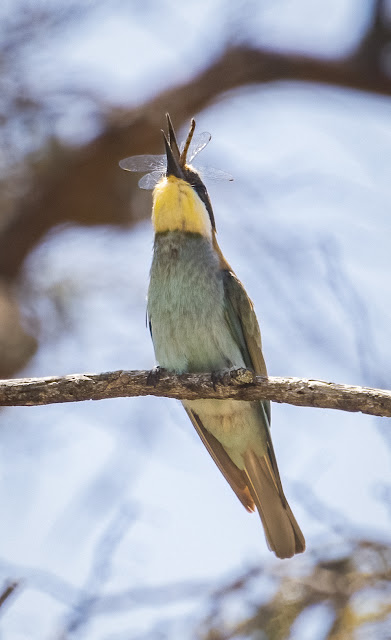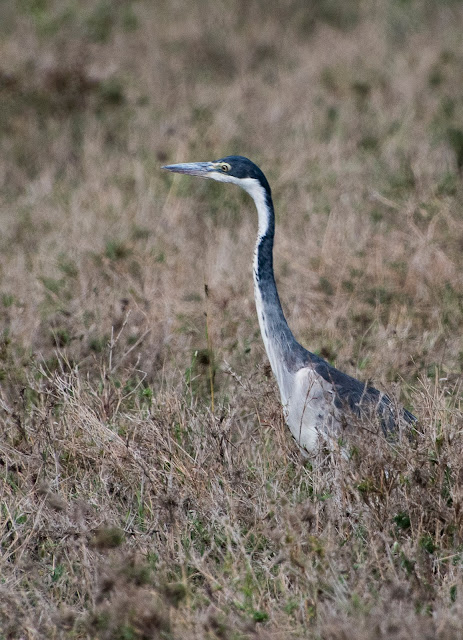Chapter 21:
In Which We Present the Birds of Solio
Africa is mystic; it is wild; it is a sweltering inferno;
it is a photographer’s paradise...--Beryl Markham
No matter where you look in African, you most likely will see a bird.
Soaring high above, perched on branches, or foraging on the ground, African bird life is rich and varied. Like Beryl Markham (quoted above) said, "It's a photographers paradise."
I have learned, though, that a lot of photographers couldn't care less about photographing birds. They want the big, showy mammals, preferably the ones standing still so they can compose their shots, dial in their settings, and shoot multiple exposures.
Hard to do that with birds. Rarely do you find a bird that sits still for long, especially with you and your long lens pointed at them.
Raptors are another matter. They will often perch as they scan for prey, leaving only when they spot something or when your presence makes them uncomfortable.
In this post, I give you the birds of Solio Ranch wildlife conservation refuge. This is the first time I've ever devoted a journals chapter exclusively to birds, but I thought it appropriate since I covered only rhinos yesterday.
Okay, I did slip in a photo of a red-billed oxpecker, but it was clinging to a rhino. And that yellow wagtail was shown next to a rhino's foot for size comparison.
But, today's it's all about birds and I'll begin with some of the many raptors I was able to photograph here.
The African Harrier-Hawk seen hanging from a branch. This is a normal activity for this raptor as it's knees are double-jointed. That enables it to hang from a weaver nest and reach inside.
In this photo, the tawny eagle is eating something on the ground that it caught. This eagle has many color variations, from dark like this one to almost blond, making it difficult for me to identity with certainty. One clue is the light colored feathers on the legs.
The two photos below are of the same juvenile fish eagle. As an adult, the streaks on the breast are gone and it's solid white.
Below is an augur buzzard. It would not turn around so I could get a photo of its facial and breast markings.
The bird below is the remarkable black-shouldered kite. Just look at those eyes!
Another shot of a tawny eagle.
Below is a Pale Chanting Goshawk. My camera settings were for a bird perched and not moving but as I depressed the shutter button for a series of photos, it lifted off by jumping straight up. Lucky, lucky me.
I guess vultures following the raptors is appropriate. These large birds are carrion eaters--the janitors that come along afterward and clean up anything edible. They are huge!
Vultures highlighted by a rainbow!
There are several kinds of vultures in the below photo'--Griffon, Lappet-faced, and White-backed that I can identify. From the neck down, they are striking birds.
Below is a lappet-faced vulture.
Now we have the water birds--ducks, geese, and the waders.
The very pretty saddle-billed stork, not shown to its best advantage because of the busy background.
A Black-headed Heron.
Yellow-billed Duck.
And the impossibly unique Gray-crowned Crane, a most striking bird. You will often find them in the dray savannahs, too.
African Spoonbills and some sandpipers.
Below, an Hadeda Ibis. Those wing colors glisten in sunlight.
Another ibis, this time a Sacred Ibis.
African Spoonbill.
Now we come to all the rest of the birds I photographed at Solio, the ones that aren't so easy to catalogue..
This is the wonderful African Hoopoe.
The wattled starling. It is oddly colored for a starling.
A Crowned Lapwing.
One of my favorites, the Secretary Bird, so called because its white "cloak and pencils in its hair" are evocative of old-time clerks.
Secretary birds prey on snakes and other reptiles and insects such as grasshoppers. Standing four feet high the bird is capable of flight, but usually does so only to reach its nest i the top of trees. A rhino photo-bombed this photo.
Little juvenile below is an Isabelline Wheatear.
The Helmeted Guineafowl, classified as a game bird.
A White-Browed Coucal.
An Isabelline Shrike, easily identified as a shrike by the end of its bill. These birds prey on other birds.
And only the second parrot I've seen in the wild, the Meyer's Parrot.
A Grassland Pipit, often seen with other birds foraging for insects around huge grazing animals.
One of the prettier starlings, the Blue-Eared Starling.
The Red-Billed Oxpecker, often seen clinging to grazing animals. They clean the beasts of lice, fleas, and ticks. In a perfect example of a symbiotic relationship, the birds create a commotion when they see danger nearing, thereby warning their host animal.
One of my favorites, the Speckled Mousebird, a crested bird with a very long tail. Though they measure 14 inches overall, half of that is tail.
A Senegal Lapwing. In resent years, many plovers were renamed lapwings and it's hard to keep track.
The always beautiful, always striking Lilac-Breasted Roller. Even my non-bird-photographer friends enjoy shooting this bird.
We caught this Northern Anteater Chat in a morning downpour.
And the bird that has defied my ability to get a good, in-focus photo of, a Jackson's Widowbird. When it flies just above the long grass of the savannah, it's tail hang almost straight down, as if it's a burden to carry. At first I thought it to be a large insect. They don't hang around near photographers.
V

And finally, my favorite birds to photograph. the beautiful Bee-Eaters. From 10 to 11 inches long, their measurement includes the tail and on some species, long forked feathers of the tail.
There are 27 species of bee-eaters, all colorful and they make wonderful subjects to photograph. On this trip, I saw at least four bee-eater species new to me.
First, the European Bee-eaters:
A couple White-chinned Bee-eaters:
Cinnamon Bee-eaters:
And then, in a perfect example of Right Place, Right Time, Right Settings--this series of photos of a Little Bee-Eater with its prey.
I can't tell if the insect is a dragonfly or a damsel fly, but it's going to be lunch regardless.
 |
| | | | As you can see, there is no way this bird can swallow such a large insect sideways.
|
 |
Whatever can it do?
|
 |
It tosses it into the air....
|
 |
And catches it head first and down it goes....
|
Sometimes it takes a while for the wings to be swallowed.
 |
And sometimes those legs tickle.
|
That's it for the birds of Solio.
Oh, wait! In the last post I promised "The Birds and the Bees." Silly me. I meant see-eaters.
Next: Time to move to another camp, but not before Murphy's Law reminds me of who's boss.





















































All About Birds. Birds, birds, and? More Birds. Your first ever post only about birds (we haven't double checked that statement). Interesting that not all photographers are interested in birds but big showy mammals who stand still while they carefully compose their photos. Photo 7 the black-shouldered kite looking at you! Photo 9, the Pale Chanting Goshawk, looks like a painting! Photo 20 the Sacred Ibis is the most unusual, odd, weird looking bird we've ever seen. Photo 33 The Red-Billed Oxpecker, often seen clinging to grazing animals. They clean the beasts of lice, fleas, and ticks. In a perfect example of a symbiotic relationship, the birds create a commotion when they see danger nearing, thereby warning their host animal. FASCINATING. Photos 48 to 53 again, FASCINATING. Wow. Too much Gullible. Cap and Patti
ReplyDeleteThank you two so much. As you can see, not many people follow along here but I can-always rely on a comment from you. It is very appreciated.
DeleteGullible, we are positive MANY people look at your website. They just don't comment. We two appreciate YOUR comments on our sites as much as you appreciate our comments here. I enjoy posting your Africa 2021 Posts on our dotnet site very much. And I know for a fact that you have readers because some of my readers have thanked me for giving them the links to your posts. Smiles .. Cap and Patti
ReplyDeleteThat’s cool! Thanks.
DeleteI have been enjoying your photo's Gullible, as well as the narration.
ReplyDeleteThank you so much, Andrej!
Delete